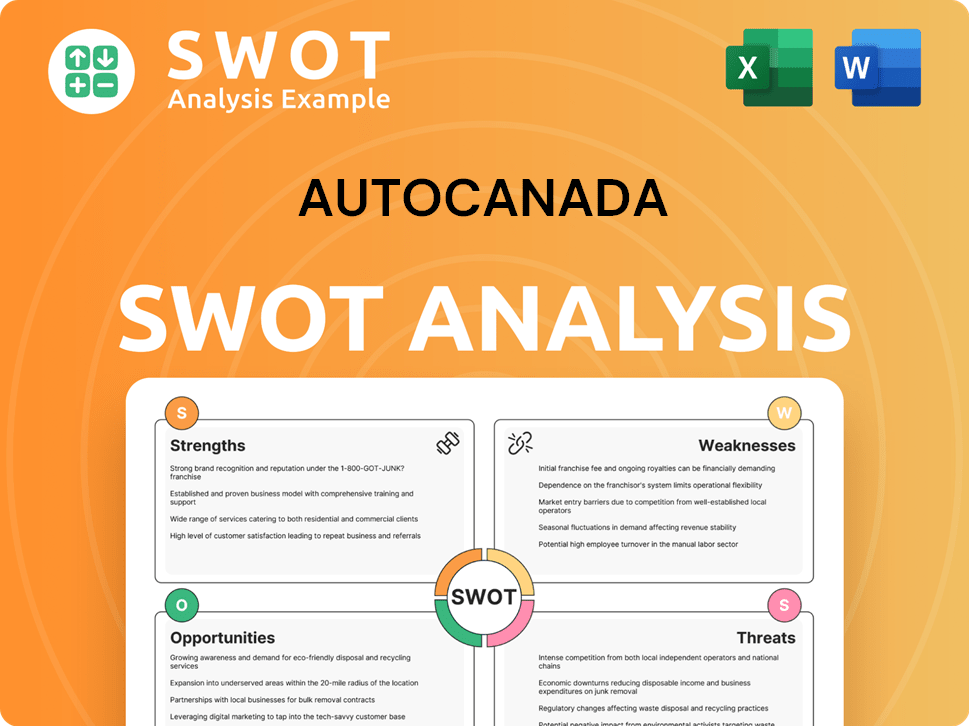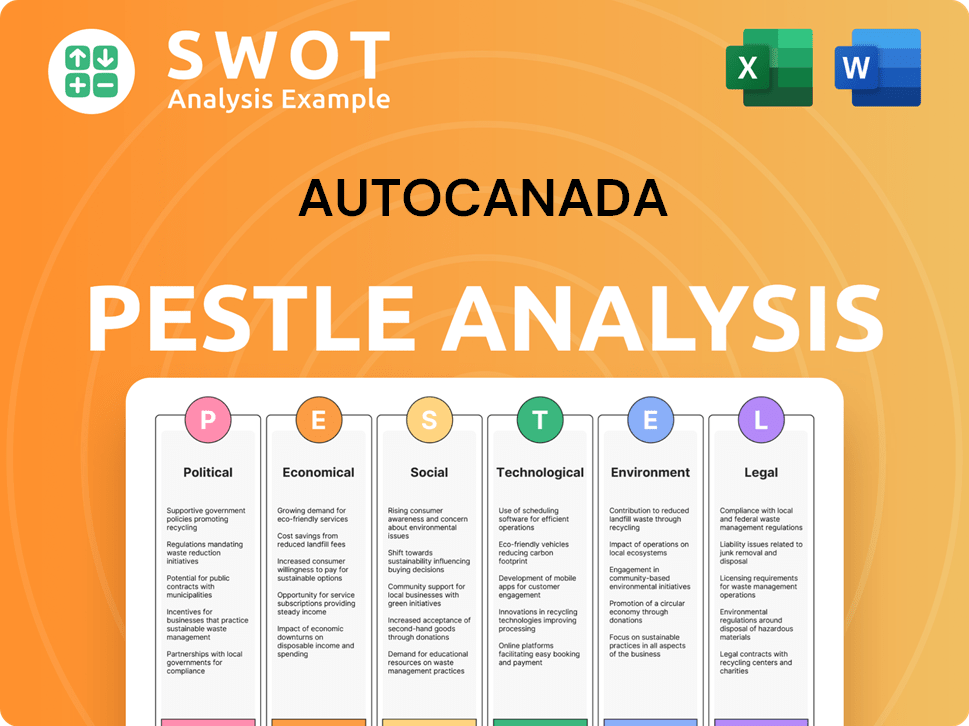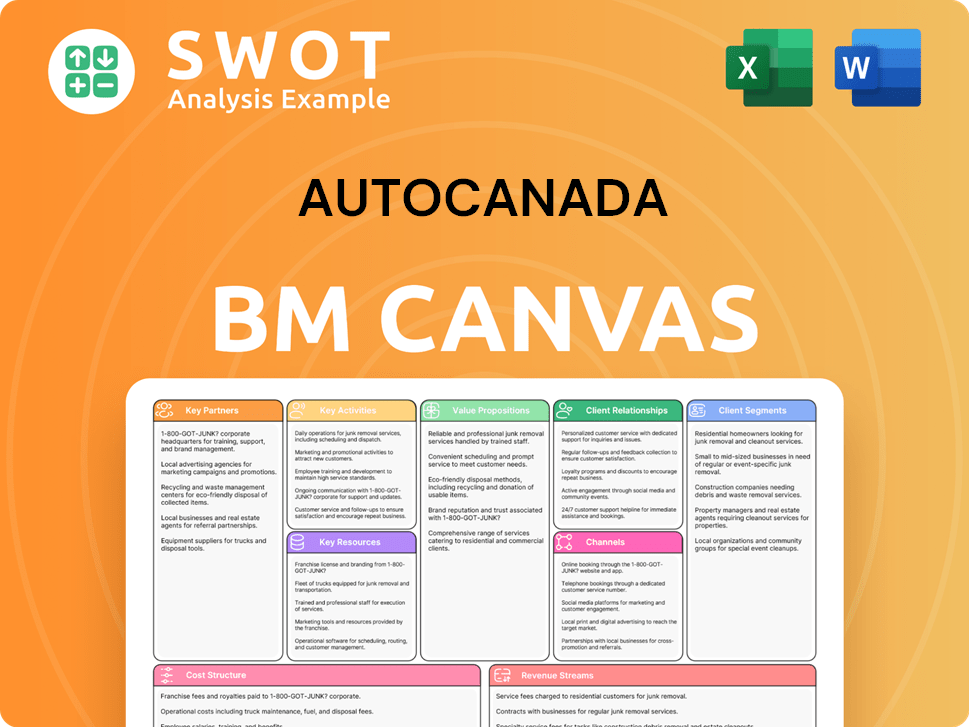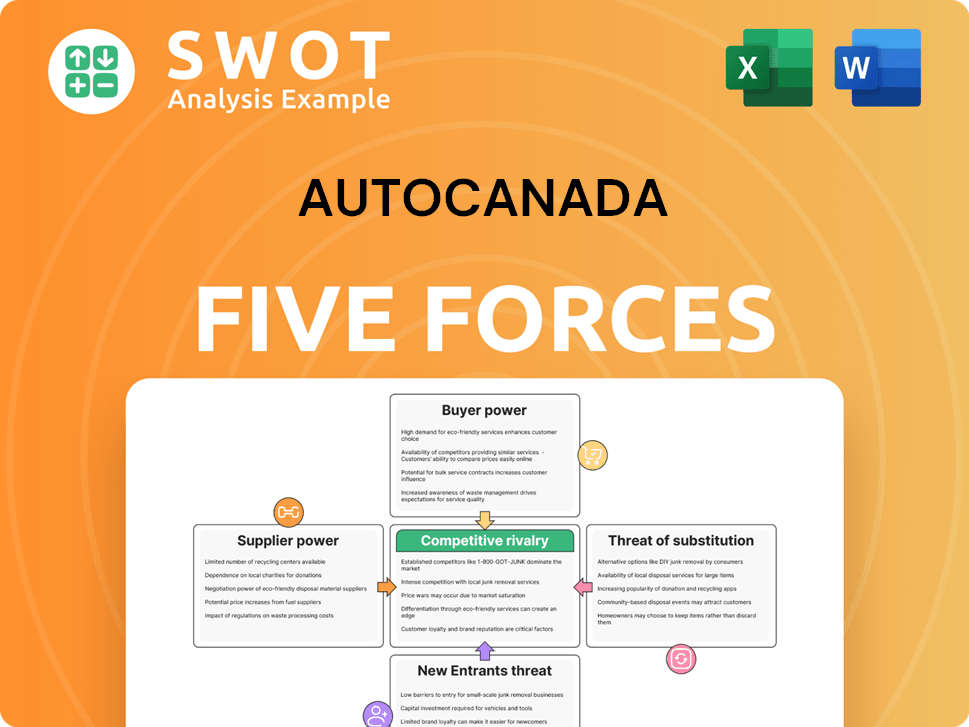AutoCanada Bundle
Who Buys Cars from AutoCanada?
Understanding the "who" behind AutoCanada's sales is crucial for its future. The company's strategic shift, launched in Q3 2024, hinges on adapting to evolving consumer behaviors and market dynamics. This analysis dives into the AutoCanada SWOT Analysis to explore the customer demographics and target market driving AutoCanada's success in the competitive automotive retail landscape.

This exploration of AutoCanada's customer profile is particularly timely given its expansion and transformation efforts. We'll examine the company's customer segmentation, including age ranges, income levels, and geographic distribution, to understand its audience better. Analyzing AutoCanada's market research data reveals valuable insights into vehicle purchase preferences and customer buying behavior, informing strategic decisions. Ultimately, this analysis aims to define AutoCanada's ideal customer profile and evaluate its customer retention strategies.
Who Are AutoCanada’s Main Customers?
Understanding the customer demographics and target market of AutoCanada is crucial for assessing its business strategies. AutoCanada primarily serves retail customers (B2C) through a network of dealerships across Canada and the United States. The company's diverse vehicle offerings, spanning various brands and price points, cater to a wide spectrum of consumers.
In 2024, AutoCanada's Canadian dealerships sold approximately 85,000 new and used retail vehicles, while its U.S. dealerships sold around 12,900. This indicates a significant customer base across different geographic locations. The company's focus on both new and used vehicle sales suggests it targets customers with varying budgets and preferences, from those seeking the latest models to those looking for more affordable options.
While specific data on AutoCanada's customer profile, including age, income, and education, isn't publicly available, the company's strategic moves provide insights. For example, the realignment of RightRide stores to offer tailored credit solutions highlights a segment of customers who may have credit challenges, indicating a focus on affordability and financial flexibility.
AutoCanada's customer base is broad, encompassing individuals and, indirectly, businesses through its vehicle offerings. The company operates across eight Canadian provinces and one U.S. state, indicating a wide geographical reach. This broad base is supported by a diverse portfolio of vehicle brands.
AutoCanada's strategic moves reveal its approach to customer segmentation. The focus on tailored credit solutions and the acquisition of dealerships like Grossinger Auto Group show an effort to cater to different customer needs. These actions are part of AutoCanada's broader market analysis.
The company's dealerships offer a wide array of vehicles, including popular brands such as Chrysler, Ford, Toyota, and Mercedes-Benz. This variety caters to different customer preferences and income levels. The sales figures of 85,000 vehicles in Canada and 12,900 in the U.S. reflect the scale of its operations.
AutoCanada aims to retain customers throughout the vehicle ownership lifecycle, as demonstrated by its collision centers. This focus on after-sales services suggests a commitment to long-term customer relationships. This approach is part of its overall customer segmentation strategy.
AutoCanada's primary customer segments include a broad range of retail consumers and those requiring specialized financing options. The company's strategic acquisitions and sales strategies have been influenced by market conditions and customer needs. The company's actions aim to refine its AutoCanada target market.
- Retail Customers: Individuals purchasing new or used vehicles across various brands and price points.
- Credit-Challenged Customers: Individuals requiring tailored credit solutions, as indicated by the RightRide initiative.
- Customers Seeking After-Sales Services: Those utilizing collision centers and other services for vehicle maintenance and repair.
- Geographic Segments: Customers located in the Canadian provinces and U.S. states where AutoCanada operates.
AutoCanada SWOT Analysis
- Complete SWOT Breakdown
- Fully Customizable
- Editable in Excel & Word
- Professional Formatting
- Investor-Ready Format

What Do AutoCanada’s Customers Want?
Understanding customer needs and preferences is crucial for businesses, and for AutoCanada, this involves a deep dive into the factors that drive consumer decisions. The company's success hinges on its ability to meet the varied demands of its customer base, from those seeking new or used vehicles to individuals requiring ongoing automotive services. This approach allows AutoCanada to tailor its offerings and strategies to effectively serve its diverse clientele.
The primary driver for many customers is the need for reliable transportation. AutoCanada addresses this by offering a wide selection of vehicles across its dealerships. The company also focuses on providing comprehensive automotive services, including parts, maintenance, and collision repair, aiming to build long-term customer relationships. This holistic approach ensures that AutoCanada remains a key player in the automotive market by catering to all aspects of vehicle ownership.
AutoCanada's strategies are also influenced by broader market dynamics. For instance, the softening market conditions in Canada in Q3 2024 highlight the importance of affordability and financing options for customers. Interest rates can impact borrowing capacity and disposable income, directly affecting consumer demand. By understanding these external factors, AutoCanada can adjust its approach to better serve its customers and maintain its competitive edge.
AutoCanada's customer base is diverse, and their needs and preferences vary. The company focuses on providing a wide range of services to meet these needs. This includes addressing common pain points and tailoring offerings to build trust and ensure high-quality service. For more insights, you can explore the Competitors Landscape of AutoCanada.
- Reliable Transportation: Customers seek dependable vehicles, which AutoCanada provides through its dealerships, offering a variety of brands.
- Affordability and Financing: With market conditions in Canada impacting consumer sensitivity, affordability and financing options are key.
- Comprehensive Automotive Services: Beyond vehicle sales, customers need parts, maintenance, and collision repair services, which AutoCanada offers through its service centers.
- Tailored Credit Solutions: AutoCanada addresses the need for credit solutions, especially for credit-challenged customers, by restructuring its operations.
- High-Quality Repairs: OEM certification sponsorships for collision centers build trust and ensure repairs align with OEM procedures.
- Data-Driven Customer Interaction: CRM systems are used to maximize revenues and profitability through data mining and multi-channel marketing.
AutoCanada PESTLE Analysis
- Covers All 6 PESTLE Categories
- No Research Needed – Save Hours of Work
- Built by Experts, Trusted by Consultants
- Instant Download, Ready to Use
- 100% Editable, Fully Customizable

Where does AutoCanada operate?
The geographical market presence of AutoCanada is primarily concentrated in North America, with a significant footprint in both Canada and the United States. This strategic positioning allows the company to cater to diverse customer demographics and market dynamics. Understanding the nuances of each region is crucial for AutoCanada's strategic decision-making and operational efficiency.
In Canada, AutoCanada operates a robust network of franchised dealerships, establishing a strong market presence across multiple provinces. The company's operations in the U.S. are focused in Illinois, where it has a presence through its U.S. Operations segment. This dual-market approach reflects AutoCanada's strategy to diversify its revenue streams and mitigate risks associated with regional economic fluctuations.
AutoCanada's Canadian dealerships sold approximately 85,000 new and used retail vehicles in 2024, demonstrating its strong foothold in the Canadian market. The U.S. dealerships sold approximately 12,900 vehicles during the same period. The company's strategic focus is currently on strengthening its position in the Canadian market, as indicated by its ongoing strategic realignments.
AutoCanada's Canadian operations include 64 franchised dealerships across 25 brands, spanning eight provinces. This extensive network supports a large customer base, catering to a wide range of preferences and needs. The company's focus on core Canadian dealerships highlights its commitment to this key market.
In the United States, AutoCanada operates through 17 franchised dealerships in Illinois, representing 15 brands. This segment, Leader Automotive Group, contributes to the company's overall revenue and market diversification. The company is actively seeking a buyer for its U.S. business assets.
AutoCanada has undertaken strategic realignments, including divesting non-core assets and restructuring RightRide operations. These moves reflect the company's response to changing market conditions and its focus on core Canadian dealerships and collision centers. The company's strategy is detailed in the Growth Strategy of AutoCanada.
- Divestiture of non-core assets.
- Restructuring of RightRide operations.
- Focus on core Canadian dealerships and collision centers.
- Seeking a buyer for U.S. business assets.
AutoCanada Business Model Canvas
- Complete 9-Block Business Model Canvas
- Effortlessly Communicate Your Business Strategy
- Investor-Ready BMC Format
- 100% Editable and Customizable
- Clear and Structured Layout

How Does AutoCanada Win & Keep Customers?
To understand the customer acquisition and retention strategies of AutoCanada, it's essential to look at how the company attracts and keeps its customers. AutoCanada uses a variety of methods, including both traditional and digital marketing, along with robust customer relationship management (CRM) systems and comprehensive service offerings. This multifaceted approach helps the company reach a wide audience and build lasting relationships.
AutoCanada has been actively adjusting its marketing strategies, focusing on digital platforms and strategic partnerships. For instance, the company is allocating resources to Google vehicle-listing ads and exploring vehicle marketplace platforms. A significant shift in 2025 involved ending its marketing relationship with AutoTrader.ca to concentrate more on organic marketing through social media platforms like Instagram, TikTok, and Facebook. This move recognizes the importance of building brand and salesperson presence on these channels. Also, AutoCanada plans to use artificial intelligence to reach buyers.
Customer acquisition is further supported by strategic partnerships, such as the expanded relationship with Kijiji, providing consumers with broader access to AutoCanada's North American inventory and integrating its Used Digital consumer solutions. Sales tactics likely involve leveraging AutoCanada's diverse vehicle portfolio, which includes 27 brands across 81 franchised dealerships, to appeal to a broad audience with varying preferences.
AutoCanada uses various digital marketing channels to reach potential customers. These include Google vehicle-listing ads, and social media platforms such as Instagram, TikTok, and Facebook. The company is also testing vehicle marketplace platforms like CarGurus.
AutoCanada forms strategic partnerships to enhance customer acquisition. An example is the expanded relationship with Kijiji, providing wider access to the company's North American inventory. These partnerships help broaden the reach and accessibility of AutoCanada's offerings.
Sales tactics involve leveraging AutoCanada's diverse vehicle portfolio. With 27 brands across 81 franchised dealerships, the company aims to cater to a wide range of customer preferences. This diverse selection helps attract and retain customers with varying needs.
AutoCanada leverages CRM systems to enhance productivity and improve operational efficiency. The use of CDK software, including a fully integrated CRM, supports these efforts. Maintaining a long-standing strategic partnership with DealerMine CRM is also important.
AutoCanada focuses on customer retention through comprehensive service offerings, including service, repair, and parts. The company's 29 collision centers play a key role in retaining customers throughout the vehicle ownership lifecycle. They also provide tailored credit solutions through the restructured RightRide operations.
- Comprehensive Service Offerings: AutoCanada emphasizes service, repair, and parts.
- Collision Centers: 29 collision centers are key for customer retention.
- Tailored Credit Solutions: RightRide operations provide credit solutions.
- CRM Systems: CDK software and DealerMine CRM are used to enhance productivity.
AutoCanada Porter's Five Forces Analysis
- Covers All 5 Competitive Forces in Detail
- Structured for Consultants, Students, and Founders
- 100% Editable in Microsoft Word & Excel
- Instant Digital Download – Use Immediately
- Compatible with Mac & PC – Fully Unlocked

Related Blogs
- What are Mission Vision & Core Values of AutoCanada Company?
- What is Competitive Landscape of AutoCanada Company?
- What is Growth Strategy and Future Prospects of AutoCanada Company?
- How Does AutoCanada Company Work?
- What is Sales and Marketing Strategy of AutoCanada Company?
- What is Brief History of AutoCanada Company?
- Who Owns AutoCanada Company?
Disclaimer
All information, articles, and product details provided on this website are for general informational and educational purposes only. We do not claim any ownership over, nor do we intend to infringe upon, any trademarks, copyrights, logos, brand names, or other intellectual property mentioned or depicted on this site. Such intellectual property remains the property of its respective owners, and any references here are made solely for identification or informational purposes, without implying any affiliation, endorsement, or partnership.
We make no representations or warranties, express or implied, regarding the accuracy, completeness, or suitability of any content or products presented. Nothing on this website should be construed as legal, tax, investment, financial, medical, or other professional advice. In addition, no part of this site—including articles or product references—constitutes a solicitation, recommendation, endorsement, advertisement, or offer to buy or sell any securities, franchises, or other financial instruments, particularly in jurisdictions where such activity would be unlawful.
All content is of a general nature and may not address the specific circumstances of any individual or entity. It is not a substitute for professional advice or services. Any actions you take based on the information provided here are strictly at your own risk. You accept full responsibility for any decisions or outcomes arising from your use of this website and agree to release us from any liability in connection with your use of, or reliance upon, the content or products found herein.